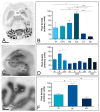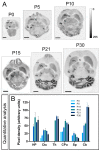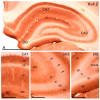Expression, Cellular and Subcellular Localisation of Kv4.2 and Kv4.3 Channels in the Rodent Hippocampus
- PMID: 30634540
- PMCID: PMC6359635
- DOI: 10.3390/ijms20020246
Expression, Cellular and Subcellular Localisation of Kv4.2 and Kv4.3 Channels in the Rodent Hippocampus
Abstract
The Kv4 family of voltage-gated K⁺ channels underlie the fast transient (A-type) outward K⁺ current. Although A-type currents are critical to determine somato-dendritic integration in central neurons, relatively little is known about the precise subcellular localisation of the underlying channels in hippocampal circuits. Using histoblot and immunoelectron microscopic techniques, we investigated the expression, regional distribution and subcellular localisation of Kv4.2 and Kv4.3 in the adult brain, as well as the ontogeny of their expression during postnatal development. Histoblot demonstrated that Kv4.2 and Kv4.3 proteins were widely expressed in the brain, with mostly non-overlapping patterns. During development, levels of Kv4.2 and Kv4.3 increased with age but showed marked region- and developmental stage-specific differences. Immunoelectron microscopy showed that labelling for Kv4.2 and Kv4.3 was differentially present in somato-dendritic domains of hippocampal principal cells and interneurons, including the synaptic specialisation. Quantitative analyses indicated that most immunoparticles for Kv4.2 and Kv4.3 were associated with the plasma membrane in dendritic spines and shafts, and that the two channels showed very similar distribution patterns in spines of principal cells and along the surface of granule cells. Our data shed new light on the subcellular localisation of Kv4 channels and provide evidence for their non-uniform distribution over the plasma membrane of hippocampal neurons.
Keywords: electron microscopy; hippocampus; histoblot; immunohistohemistry; potassium channel.
Conflict of interest statement
The authors declare no conflict of interest.
Figures









Similar articles
-
Cellular and Subcellular Localisation of Kv4-Associated KChIP Proteins in the Rat Cerebellum.Int J Mol Sci. 2020 Sep 3;21(17):6403. doi: 10.3390/ijms21176403. Int J Mol Sci. 2020. PMID: 32899153 Free PMC article.
-
Kv4.2 potassium channels segregate to extrasynaptic domains and influence intrasynaptic NMDA receptor NR2B subunit expression.Brain Struct Funct. 2013 Sep;218(5):1115-32. doi: 10.1007/s00429-012-0450-1. Epub 2012 Aug 30. Brain Struct Funct. 2013. PMID: 22932868 Free PMC article.
-
Ontogenic Changes and Differential Localization of T-type Ca(2+) Channel Subunits Cav3.1 and Cav3.2 in Mouse Hippocampus and Cerebellum.Front Neuroanat. 2016 Aug 26;10:83. doi: 10.3389/fnana.2016.00083. eCollection 2016. Front Neuroanat. 2016. PMID: 27616982 Free PMC article.
-
KCND3-Related Neurological Disorders: From Old to Emerging Clinical Phenotypes.Int J Mol Sci. 2020 Aug 13;21(16):5802. doi: 10.3390/ijms21165802. Int J Mol Sci. 2020. PMID: 32823520 Free PMC article. Review.
-
Histoblot: A sensitive method to quantify the expression of proteins in normal and pathological conditions.Histol Histopathol. 2023 Jul;38(7):725-737. doi: 10.14670/HH-18-581. Epub 2023 Jan 5. Histol Histopathol. 2023. PMID: 36648032 Review.
Cited by
-
Paradoxical relationships between active transport and global protein distributions in neurons.Biophys J. 2021 Jun 1;120(11):2085-2101. doi: 10.1016/j.bpj.2021.02.048. Epub 2021 Apr 2. Biophys J. 2021. PMID: 33812847 Free PMC article.
-
Ion-channel regulation of response decorrelation in a heterogeneous multi-scale model of the dentate gyrus.Curr Res Neurobiol. 2021 Mar 5;2:100007. doi: 10.1016/j.crneur.2021.100007. eCollection 2021. Curr Res Neurobiol. 2021. PMID: 33997798 Free PMC article.
-
Dendritic Excitability and Synaptic Plasticity In Vitro and In Vivo.Neuroscience. 2022 May 1;489:165-175. doi: 10.1016/j.neuroscience.2021.12.039. Epub 2022 Jan 5. Neuroscience. 2022. PMID: 34998890 Free PMC article. Review.
-
Design of Ultrapotent Genetically Encoded Inhibitors of Kv4.2 for Gating Neural Plasticity.J Neurosci. 2024 Feb 14;44(7):e2295222023. doi: 10.1523/JNEUROSCI.2295-22.2023. J Neurosci. 2024. PMID: 38154956 Free PMC article.
-
Pharmacological Approaches for the Modulation of the Potassium Channel KV4.x and KChIPs.Int J Mol Sci. 2021 Jan 31;22(3):1419. doi: 10.3390/ijms22031419. Int J Mol Sci. 2021. PMID: 33572566 Free PMC article. Review.
References
-
- Anderson P., Morris R., Amaral D., Bliss T., O’Kefefe J. The Hippocampus Book. Oxford University Press Inc.; New York, NY, USA: 2007.
-
- MacDonald J.F., Belrose J.C., Xie Y.F., Jackson M.F. Nonselective cation channels and links to hippocampal ischemia, aging, and dementia. Adv. Exp. Med. Biol. 2013;961:433–447. - PubMed
-
- Hille B. Ionic Channels of Excitable Membranes. Sinauer Associates Inc.; Sunderland, MA, USA: 2001.
MeSH terms
Substances
Grants and funding
LinkOut - more resources
Full Text Sources

